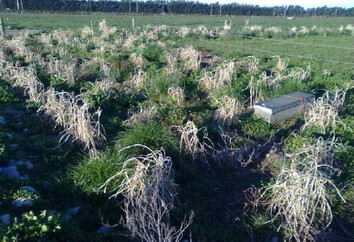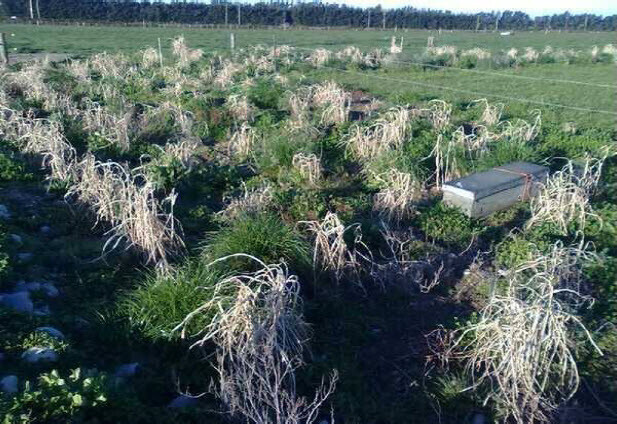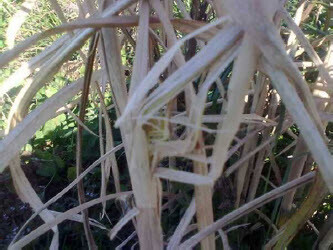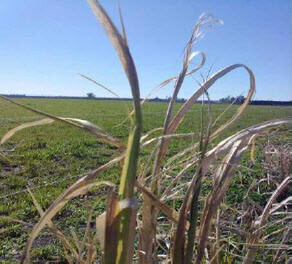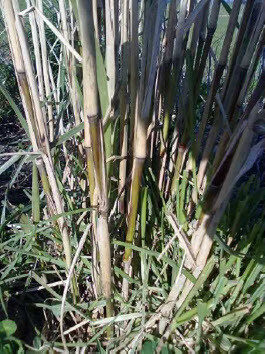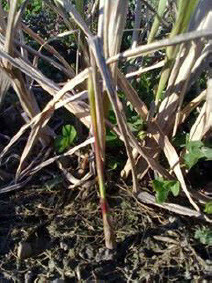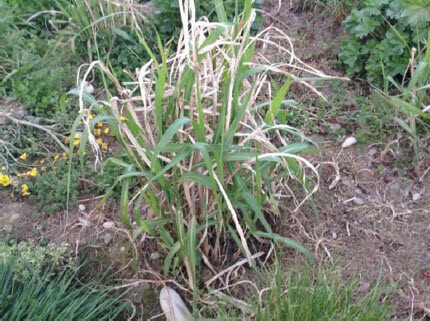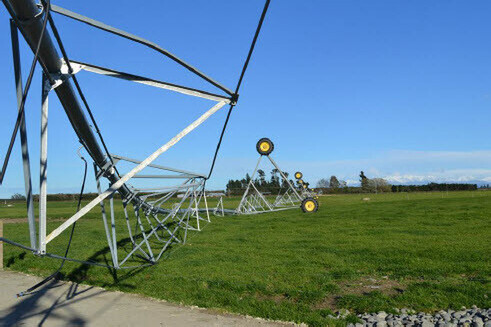Biofuel feedstocks as co-products on dairy farms: income and sustainability benefits.
Project Update. Period: to Sept 29, 2013
Chris Littlejohn, Bio-Protection Research Centre, P O Box 85084, Lincoln University. p: +64 3 325 3838 extension: 8639 Mob. +64 2108204285
Funders; Westland Milk Products and DairyNZ, + support from Agresearch
Spring Update; Season Two
Fig.1: Miscanthus plants September 7, 2013; paddock 22 Aylesbury farm.
Crop News
The first signs of re-growth started to appear at the beginning of September. Stems that senesced over the winter remained soft and did not stiffen to produce harder stems, as had been expected (Fig.2).
Fig.2: Last summer’s stems after moving their nutrient content to the rhizome; paddock 22, Aylesbury Farm, Oct 7, 2013.[/mks_one_half]
Fig.3: Leaf growth from the top of previously-senesced stems; paddock 22, Aylesbury Farm, Oct 7, 2013.
This may be a feature of first season’s growth or may have been a consequence of the relatively mild winter resulting in a slower rate of nutrient transfer. M. x gianteus (Mxg) is not harvested in its first season but when considering future harvest date research (Lewandowski and Heinz 2003) shows energy yield is reduced the later the harvest date, due to nutrient content decreasing as nutrients are translocated to the rhizome. Interestingly some of these stems greened up again in September and initially produced leaves (Figs. 3 and 4) but these died back during a period of frosty mornings.
Fig. 4: Greening of Miscanthus stems; paddock 6, September 7, 2013 Aylesbury Farm
Fig.5: Miscanthus shoots first appeared at the beginning of September; paddock 21 Aylesbury Farm.
Early September also saw the first appearance of new shoots (Fig 5). Frequent frosts and a lowering in soil temperatures kept any further regrowth in check until the end of September when significant sprouting and growth from the base of plants was visible (Fig.6).
Fig.6: Vigorous growth from Mxg plants; paddock 6, Aylesbury Farm, Oct 1, 2013.
Whether this spring growth is again is checked by late frosts will be interesting to see. Zub and Brancourt-Hulmel’s (2009) research on crop production in Europe suggests frost tolerance is a breed trait that needs to be improved if Mxg is to be produced in colder regions. Their research indicates susceptibility to winter frost at temperatures below −8 °C for rhizomes and −3.5 °C for young shoots of Mxg can lead to significant plant losses and lower yields. Research by Lewandowski et al (2000) also indicates that in the first winter following planting, the rather shallow and under-developed rhizomes can often be damaged or destroyed by cold and or wet conditions. There are no reports of over-wintering problems in the second and subsequent winters. This year’s relatively mild Canterbury winter should prove to be a bonus to this season’s plant growth and well developed shelterbelts should be the outcome from those Mxg plantings in irrigated paddocks. This is providing that the damage caused to the centre pivot at Aylesbury Farm by the recent storm that hit the region on the September 10 (Fig.7) is repaired before water stress levels become too severe. The immediate area surrounding Aylesbury Farm suffered extensive tree damage, something that would not occur with Miscanthus shelterbelts at this time of year as above ground material would have been harvested or senesced. With harvested plots no stock shelter would be available but with senesced plants some shelter protection is still present.
If high Mxg yields of 30 Tonnes-1 ha or more are to be achieved in the Canterbury region then lasts years growth studies, where irrigated plants were on average a metre taller than unirrigated ones, indicates that irrigation is essential. The observations of frost effect on young growth also suggest that in particularly cold winters mulching may be necessary to mitigate any crop damage in the first winter.
Fig.7: Damage to the Centre Pivot at Aylesbury Farm, September 12, 2013
Effects of Mxg plantings on biodiversity
Research in Europe (Semere and Slater 2006) showed that since perennial rhizomatous grasses require a single initial planting and tillage only at time of planting, and also no major chemical inputs, and where the crops are harvested in the spring and the land is not disturbed by cultivation every year, the fields were used as over-wintering sites for invertebrates, suggesting immediate benefits to biodiversity. Similar studies have also shown variable benefits for woodland bird species depending on canopy density, weediness and stage of growth. Winter weed control has been minimal in Mxg plantings on Aylesbury Farm and only the removal of any weeds at the base of each plant was performed once sprouting had been observed (Fig. 5). In the only one remaining Mxg planting on Springston Farm, which is partially irrigated, there has been no weed control to see if Mxg plants will push through the existing weed cover. This will give information on levels of weed control necessary to allow unhindered crop growth. All the remaining plots which were unirrigated and had poor growth last season have had blanket spraying of a broad leaved herbicide to remove weed so as to help initial growth of these weaker plants.
Research work over the winter months
Winter months have been spent analysing base-line data which will be used to benchmark any shelter effects in the coming seasons and preparing progress reports. Further soil analysis has been undertaken and soil moisture profiles prepared. This will form an important part of analysis of varying pasture water stress levels due to shelter effect. Bumble motels have been serviced and restocked with bedding material and baseline earthworm counts have been taken. A fifteen month progress report has been submitted to Lincoln University and this will be supported by a presentation on 20 Oct 2013.
DairyNZ provide funding support
One successful outcome of winter activities has been a successful funding application to DairyNZ for data-logging equipment. The allocation of $25,000 will be used to purchase real time monitoring equipment which will be used to assess pasture water stress using canopy temperature as an index. Plants suffering water stress will close their stomata which results in an increase in leaf temperature due to reduced evapotranspiration. This can be detected using infra-red thermometers and used to calculate stomatal conductance. Equipment will be set up to try and achieve this and a hand held porometer, which directly measures stomatal conductance, will be used to calibrate readings. The canopy temperature will then be used to directly indicate plant water stress levels in real-time and at the same time soil moisture levels will be monitored. This work will provide information on whether water stress levels are reduced by shelter and also provide information on optimising irrigation efficiency.
DairyNZ will also help promote methods of best practice for growing Mxg on dairy farms which will also be generated by this research. This contribution is very much appreciated and complements the support provided by Westland Milk Products.
Open Day
An open day has been organised for 20 February 2014 at Aylesbury Farm to provide information on the agronomy of Mxg, research results gained so far and to illustrate the shelter effect of Mxg as by then it should be 3 m high. The aim is to illustrate, using existing plantings, how miscanthus can fit into the dairy production system. Westland Milk Products and DairyNZ will be helping to organise the day. Specialists from DairyNZ, Westland Milk Products, Agresearch and Lincoln University will be present. DairyNZ will be assisting in producing publication material and a BBQ will be provided. A reminder will be posted nearer the time but please put the date in your diaries.
The future of Miscanthus in New Zealand
Negotiations and planning are well under way between Lincoln University and a Californian company to develop in New Zealand a small-scale, portable unit which makes 150 litres-1 hour of renewable diesel. The ‘drop-in’ renewable diesel can be made, through a catalytic process, from any cellulosic material, including miscanthus, cardboard, paper, straw etc. This product can be used as boiler fuel or for transport and has been approved by the state of California as a road fuel with no further treatment – unlike biodiesel from plant oils where transesterification is needed. Prof. Steve Wratten of the Bio-Protection Centre at Lincoln University and Peter Brown from Miscanthus New Zealand Ltd will have a meeting with the California Company later in October.
Chris Littlejohn
References
Lewandowski I, Heinz A (2003). Delayed harvest of miscanthus—influences on biomass quantity and quality and environmental impacts of energy production. European Journal of Agronomy 19, 45-63.
Lewandowski, I. , Clifton-Brownb,I., Scurlockc,J. and Huismand,W., (2000). European experience with a novel energy crop. Biomass and Bioenergy Volume 19, Issue 4, October 2000, Pages 209–227
Semere, T et Slater F.M (2007). Invertebrate populations in miscanthus and reed canary-grass. Biomass and Bioenergy 31 : 30 – 39.
Zub, H. and Brancourt-Hulmel, M (2009 ) Agronomic and physiological performances of different species of Miscanthus, a major energy crop. A review Agronomy for Sustainable Development, Volume 30, Number 2, April 2009 , pp. 201-214(14)
